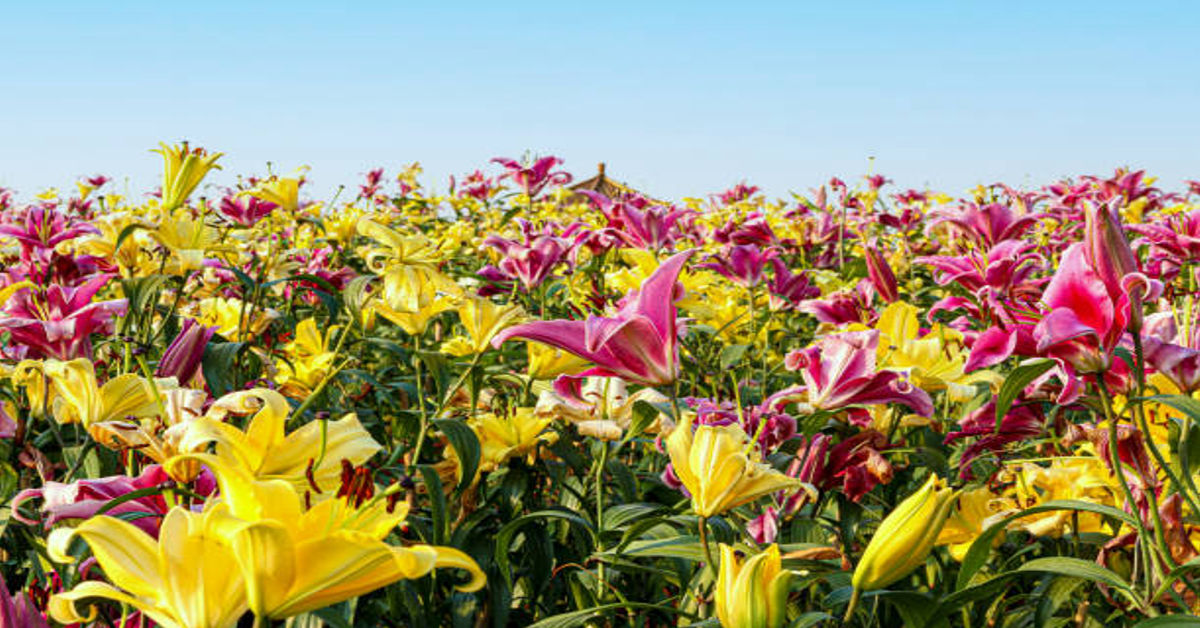Few flowers embody elegance, purity, and timeless beauty like the lily. Known scientifically as Lilium, lillies have captivated humans for thousands of years with their exquisite shapes, heavenly fragrance, and vibrant range of colors. Whether found in a wild meadow, a bridal bouquet, or a tranquil garden, lillies command attention and admiration wherever they bloom.
This guide explores everything about these remarkable flowers — from their ancient symbolism and diverse species to their modern uses, cultivation techniques, and even their role in art and medicine. We will take a deep dive into the world of lillies to understand what makes them one of nature’s most beloved blooms.
🌼 1. What Are Lillies?
Lillies belong to the genus Lilium, which comprises over 100 species of flowering plants in the family Liliaceae. They are native to the temperate regions of the Northern Hemisphere — mainly parts of Europe, North America, and Asia.
Unlike many flowering plants that die back after one season, lillies are perennial bulbs, meaning they regrow year after year when properly cared for. They are prized for their large, often trumpet-shaped flowers and long, slender stems that make them a favorite in gardens and floral arrangements alike.
Lillies come in an astonishing variety of forms, from tall, showy hybrids used in landscaping to small, delicate species that thrive in pots or shaded areas.
🌷 2. The History and Symbolism of Lillies
Throughout history, lillies have held deep symbolic meaning across cultures, representing everything from purity and virtue to renewal and love.
| Culture | Symbolic Meaning of Lillies |
|---|---|
| Ancient Egypt | Fertility and rebirth; often placed in tombs. |
| Greek Mythology | Associated with Hera, symbolizing motherhood and purity. |
| Christian Tradition | The “Madonna Lily” symbolizes the Virgin Mary’s purity. |
| Victorian Era | Used to express emotions through “floriography” (the language of flowers). |
| China | Linked with good luck, marriage, and prosperity. |
| Modern Symbolism | Represents peace, purity, and transformation. |
In funeral traditions, white lillies are often used to represent the restored innocence of the soul of the deceased. In weddings, they symbolize everlasting love and unity.
The versatility of their meaning allows lillies to play a role in nearly every stage of life — from birth to love, and from remembrance to spiritual reflection.
🌸 3. Major Types and Varieties of Lillies
There are hundreds of natural and hybrid varieties of lillies, each with unique characteristics. However, botanists commonly classify them into several broad divisions based on their genetic lineage and physical traits.
| Division | Type of Lily | Description | Bloom Time |
|---|---|---|---|
| Asiatic Hybrids | Asiatic Lilies | Early bloomers; wide color range; little fragrance | Early Summer |
| Martagon Hybrids | Turk’s Cap Lilies | Downward-facing flowers; prefer cool climates | Mid Summer |
| Candidum Hybrids | Madonna Lily | Iconic white lily of ancient Europe | Late Spring |
| American Hybrids | North American species | Unique speckled petals; tall stems | Mid Summer |
| Longiflorum Hybrids | Easter Lilies | Large, trumpet-shaped white blooms | Spring |
| Trumpet & Aurelian Hybrids | Oriental-Trumpet mix | Sweetly fragrant, long-lasting | Mid to Late Summer |
| Oriental Hybrids | Stargazer, Casablanca | Large blooms with strong fragrance | Late Summer |
Among these, Asiatic and Oriental lillies are the most commonly cultivated for gardens and floral arrangements due to their beauty and adaptability.
🌿 4. Anatomy of a Lily
Understanding the anatomy of a lily helps gardeners care for them more effectively.
| Part of Lily | Function / Description |
|---|---|
| Bulb | Underground storage organ containing nutrients for regrowth. |
| Stem | Supports flowers and leaves; carries nutrients upward. |
| Leaves | Lance-shaped, arranged alternately along the stem. |
| Flower | Composed of six petals (tepals), stamens, and a central pistil. |
| Anthers | Pollen-bearing part of the stamen; responsible for reproduction. |
| Pistil | Female part of the flower; receives pollen for fertilization. |
| Roots | Anchor the plant and absorb water and minerals. |
This intricate structure not only contributes to the lily’s physical beauty but also its resilience and reproductive success.
🌼 5. How to Grow Lillies Successfully
Growing lillies is rewarding and not overly complicated if you understand their needs. Here’s a detailed guide to growing healthy, thriving plants.
A. Choosing the Right Location
Lillies need plenty of sunlight — at least 6–8 hours a day. They prefer well-drained soil since their bulbs can rot in soggy conditions. If your garden soil retains water, consider planting them in raised beds or large pots.
B. Soil Preparation
The ideal soil for lillies is loamy, rich in organic matter, and slightly acidic to neutral (pH 6.0–7.0). Adding compost or aged manure before planting ensures a strong nutrient base.
C. Planting Depth and Spacing
Lily bulbs should be planted about 6–8 inches deep and spaced 8–12 inches apart. The deeper the bulb, the better it resists toppling over in wind and maintains consistent moisture.
| Step | Action | Details |
|---|---|---|
| 1 | Choose healthy bulbs | Firm, mold-free bulbs are best |
| 2 | Prepare soil | Mix compost, sand, and organic matter |
| 3 | Plant bulbs | Pointed end up, roots down |
| 4 | Water thoroughly | Keep soil moist but not soggy |
| 5 | Mulch layer | Helps retain moisture and suppress weeds |
D. Watering
Water lillies deeply once a week, more often in dry climates. Avoid overhead watering to prevent fungal diseases; water directly at the base instead.
E. Fertilizing
A balanced slow-release fertilizer (10-10-10) applied in early spring encourages strong growth and abundant blooms. Avoid excessive nitrogen, as it promotes leaves over flowers.
F. Mulching and Weeding
Use organic mulch (like bark or straw) to retain soil moisture. Regular weeding ensures lillies don’t compete with invasive plants for nutrients.
🌸 6. Caring for Lillies Year-Round
After planting, maintenance is the key to long-term success.
During Blooming Season:
- Remove spent flowers to prevent seed formation and direct energy back into the bulb.
- Stake tall varieties to prevent bending in wind.
- Watch for pests such as aphids, red lily beetles, and slugs.
After Blooming:
- Allow leaves to die back naturally — this helps store nutrients for the next season.
- Trim stems once they turn brown.
Winter Care:
In colder regions, cover bulbs with mulch or straw to protect them from frost. In warm climates, lillies can remain in the ground year-round.
🌿 7. Common Diseases and Pests
| Problem | Symptoms | Solution |
|---|---|---|
| Lily Beetle | Red beetles, eaten leaves | Handpick or use neem oil spray |
| Botrytis Blight (Gray Mold) | Brown spots on leaves | Improve air circulation, avoid overhead watering |
| Bulb Rot | Soft, mushy bulbs | Ensure proper drainage; avoid overwatering |
| Aphids | Sticky residue, curled leaves | Wash off with mild soap water |
| Slugs/Snails | Holes in leaves | Use barriers or organic pellets |
Healthy soil and good spacing are the best defenses against these issues.
🌼 8. Propagation of Lillies
Lillies can be propagated through several methods:
- Bulb Division:
Every 3–4 years, divide crowded bulbs in autumn. Replant immediately for new growth. - Bulbils:
Some species produce tiny bulbs in leaf axils. Collect and plant them when mature. - Scaling:
Carefully remove outer scales from a bulb, plant them in moist soil, and wait for baby bulbs to form. - Seeds:
Though slower, growing from seed can produce unique hybrids over several years.
Propagation allows gardeners to expand their collection and even create new color combinations.
🌷 9. Popular Types of Lillies for Home Gardens
| Common Name | Scientific Name | Color Range | Fragrance | Best Use |
|---|---|---|---|---|
| Asiatic Lily | Lilium asiaticum | Yellow, red, orange | Mild | Borders, pots |
| Oriental Lily | Lilium orientale | Pink, white, red | Strong | Bouquets, gardens |
| Trumpet Lily | Lilium longiflorum | White, cream | Sweet | Indoor/outdoor decor |
| Tiger Lily | Lilium lancifolium | Orange with spots | Mild | Wildflower gardens |
| Easter Lily | Lilium longiflorum | White | Sweet | Religious occasions |
| Turk’s Cap Lily | Lilium martagon | Purple, red | Medium | Woodland gardens |
| Stargazer Lily | Lilium ‘Stargazer’ | Pink with white edges | Intense | Weddings, cut flowers |
Each has its unique charm — from the understated simplicity of the Asiatic lily to the heady perfume of the Oriental varieties.
🌸 10. The Symbolic Color Meanings of Lillies
Color often conveys emotion, and lillies come in nearly every shade imaginable.
| Color | Meaning |
|---|---|
| White | Purity, virtue, spiritual awakening |
| Pink | Love, admiration, and compassion |
| Red | Passion and deep romantic love |
| Orange | Confidence, warmth, and creativity |
| Yellow | Cheerfulness and gratitude |
| Purple | Royalty, pride, and success |
Understanding color symbolism helps in choosing the right lily for occasions such as weddings, anniversaries, or condolences.
🌿 11. Lillies in Art, Literature, and Culture
The lily has been a timeless muse for artists and poets. Ancient Egyptian carvings, Renaissance paintings, and Victorian poetry all celebrate its delicate beauty.
- Art: Often seen in religious paintings symbolizing purity.
- Literature: William Blake and William Wordsworth referenced lillies as symbols of innocence and divine grace.
- Modern Culture: Lillies appear frequently in branding, perfume, and wedding decor.
Their iconic shape and ethereal scent make them a symbol that transcends eras and cultures.
🌼 12. Lillies in Medicine and Perfume
Certain species of lilies have medicinal and aromatic uses:
- Medicinal Uses:
The bulbs of some species, like Lilium candidum, were used historically for treating inflammation, burns, and ulcers. - Aromatherapy:
Lily essential oils are used for relaxation and emotional balance. - Perfumery:
Lily scent is a common note in luxury perfumes for its floral, sweet fragrance.
However, some lilies (especially for pets like cats) are toxic — ingestion can lead to serious illness. Always keep them out of reach of animals.
🌷 13. Eco and Emotional Benefits of Growing Lillies
Beyond aesthetics, growing lillies provides ecological and emotional benefits:
- Air Purification: Plants absorb pollutants and refresh indoor air.
- Pollinator Support: Bees and butterflies love lily nectar.
- Mental Health: Gardening reduces stress and promotes mindfulness.
- Environmental Harmony: Perennials like lillies help maintain soil structure and prevent erosion.
Caring for flowers fosters patience, joy, and a sense of connection with nature.
🌸 14. Tips for Floral Arrangements with Lillies
To make your lillies last longer in vases:
- Cut stems diagonally under water.
- Remove lower leaves that may rot in water.
- Add floral preservative or sugar.
- Keep away from direct sunlight or heat.
- Replace water every two days.
Cut lillies often last up to two weeks if properly maintained.
🌿 15. Future of Lillies: Hybrids and Sustainability
Breeders continue developing new hybrids that are disease-resistant, longer-lasting, and more colorful. Sustainable cultivation focuses on reducing pesticide use, promoting organic soil health, and conserving native lily species threatened by habitat loss.
The future of lillies is bright — combining ancient elegance with modern science.
🌸 Conclusion
Lillies are more than flowers; they are living symbols of beauty, resilience, and spirituality. Their rich history, wide variety, and deep cultural roots make them a staple in gardens and hearts worldwide.
From the humble Asiatic to the majestic Oriental, every lily tells a story — of love, purity, transformation, and grace. Whether you grow them for their fragrance, their symbolism, or their stunning appearance, lillies will always reward your care with blooms that light up both your garden and your spirit.
So plant them deeply, nurture them patiently, and watch as they bring elegance, joy, and meaning to your world — year after year.
🌼 Frequently Asked Questions (FAQs)
1. What is the best time to plant lillies?
The best time to plant lily bulbs is in spring or fall, when the soil is cool but workable. Fall planting often produces stronger blooms since the bulbs establish roots before winter.
2. How long do lily flowers last?
Once bloomed, lily flowers typically last 7–14 days, depending on the variety and environment. Deadheading spent flowers can prolong the blooming period.
3. Are lillies easy to grow for beginners?
Yes, lillies are beginner-friendly. With the right sunlight, well-drained soil, and regular watering, they thrive in most home gardens or pots.
4. Can lillies grow indoors?
Yes, smaller varieties like Asiatic lillies can grow indoors with sufficient light. Use a bright window or artificial grow lights and ensure proper drainage.
5. Are lillies toxic to pets?
Unfortunately, yes. All parts of the lily plant are highly toxic to cats and can cause kidney failure. Always keep them out of pet areas.









